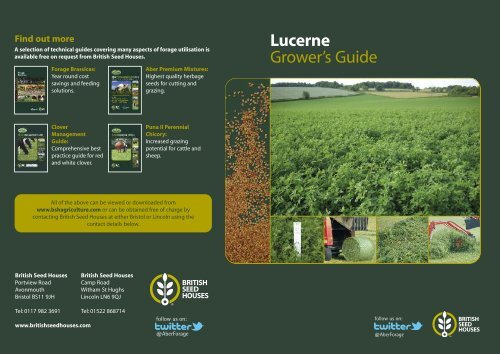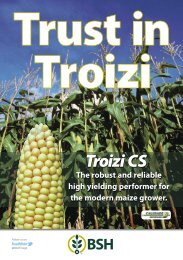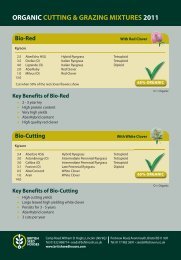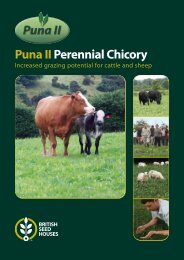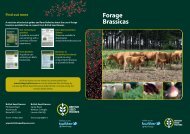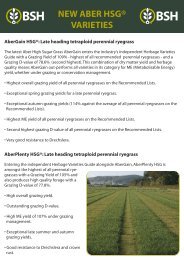Lucerne Growers Guide - British Seed Houses
Lucerne Growers Guide - British Seed Houses
Lucerne Growers Guide - British Seed Houses
- No tags were found...
You also want an ePaper? Increase the reach of your titles
YUMPU automatically turns print PDFs into web optimized ePapers that Google loves.
Find out moreA selection of technical guides covering many aspects of forage utilisation isavailable free on request from <strong>British</strong> <strong>Seed</strong> <strong>Houses</strong>.Forage Brassicas:Year round costsavings and feedingsolutions.Aber Premium Mixtures:Highest quality herbageseeds for cutting andgrazing.<strong>Lucerne</strong>Grower’s <strong>Guide</strong>CloverManagement<strong>Guide</strong>:Comprehensive bestpractice guide for redand white clover.Puna II PerennialChicory:Increased grazingpotential for cattle andsheep.All of the above can be viewed or downloaded fromwww.bshagriculture.com or can be obtained free of charge bycontacting <strong>British</strong> <strong>Seed</strong> <strong>Houses</strong> at either Bristol or Lincoln using thecontact details below.<strong>British</strong> <strong>Seed</strong> <strong>Houses</strong>Portview RoadAvonmouthBristol BS11 9JH<strong>British</strong> <strong>Seed</strong> <strong>Houses</strong>Camp RoadWitham St HughsLincoln LN6 9QJTel: 0117 982 3691 Tel: 01522 868714www.britishseedhouses.comfollow us on:@AberForagefollow us on:@AberForage
Contents:Introduction<strong>Lucerne</strong> for the modern farming era3 Introduction• <strong>Lucerne</strong> for the modern farming era• <strong>Lucerne</strong> in comparison to red and white clovers4 Site selection and preparation• <strong>Seed</strong> bed preparation5 Sowing and establishment• Inoculation• Sowing with a nurse crop• <strong>Seed</strong> rates6 Crop management• Key points in lucerne persistency7 Pests and diseases• Common pests and diseases of lucerne8 Cutting, grazing and feeding lucerne• <strong>Lucerne</strong> cutting regimes• Cutting best practice• Ensiling best practice• Grazing best practice• Yields and Feed Quality10 Variety selection• Timbale11 Views from the field• TestimonialsInterest amongst UK livestock farmers in lucerne as a forage crop has increasedsignificantly in recent years. The crop’s potential to provide an economic source ofhomegrown protein whilst reducing reliance on bought-in fertiliser by up to300kgN/ha are good reasons for farmers’ willingness to revisit lucerne or grow it forthe first time.As a nitrogen-fixing legume, lucerne is commonly compared with white and redclover, and its similarities with the latter extend also to its ability to thrive in dryconditions, due to its deep tap root.<strong>Lucerne</strong> is most commonly grown as a stand-alone crop, primarily for cutting butwith limited grazing potential. Whether cut or grazed, the forage is highly digestibleand typically rich in minerals due to its deep rooting nature. With the correctmanagement, crops should persist for 4 – 6 years, producing 10-15 tonnesDM/ha at18-24% crude protein.Variety choice, as with any cropping option, is critical. For the UK grower, winterhardiness and disease resistance are key characteristics, and recent breedingprogress is now increasing the viability of lucerne as a mainstream forage crop.<strong>Lucerne</strong> is highly suited to organic systems.CHARACTERISTIC RED CLOVER WHITE CLOVER / GRASS LUCERNESoil type All types All types Well drainedIdeal pH 5.8-7.5 5.8-7.0 6.2-8.5Establishment rate Fast Medium MediumInoculation needed No No YesDrought tolerance High Medium Very highPersistence Low Very high MediumRegrowth rate High High HighYield 10-15 tonnes DM/ha 4-10 tonnes DM/ha 10-15 tonnes DM/haSilage quality ME 9.8-11 MJ/kg/DM ME 9.8-12 MJ/kg/DM ME 9.0-11 MJ/kg/DMCP 16-22% CP 16-20% CP 18-24%pH 4-4.5 pH 3.5-5.5 pH 4.3-4.4Other features High PPO* Low PPO Low PPOSources: Legume Silages for Animal Production, R.J. Wilkins; Legumes for Milk and Meat, R. Shedrick, G. Newman and D.J. Roberts* PPO (Polyphenol oxidase) is an enzyme that enables animals to utilise protein more efficiently.2 • LUCERNE GROWER’S GUIDELUCERNE GROWER’S GUIDE • 3
Site selection and preparationSowing and establishmentModern varieties of lucerne selected for their suitability to a northern Europeanclimate can be grown successfully on a wide range of fertile free-draining sites andsoil types. <strong>Lucerne</strong> will not thrive in waterlogged soils, so the general advice is toavoid heavier land and cold wet soils.For optimum performance and to minimise the threat of pests and diseases, a periodof five years should be allowed in the rotation between lucerne crops. <strong>Lucerne</strong> offersthe advantage of leaving significant residual nitrogen for following crops.<strong>Seed</strong> bed preparation<strong>Lucerne</strong> is slow to establish so it is very important to ensure the correct balance ofsoil nutrients are in place and that any soil compaction and perennial weed issuesare remedied in advance.Soil nutrient testing should be carried out to assess requirements to achieve a pH inthe range 6.2 – 8.5 and soil indices of at least 2 for both phosphate and potash. Thetrace elements magnesium, sulphur, molybdenum and boron are particularlyimportant in the establishment phase.Calcium is essential for nodulation and nitrogen fixation; it is unlikely to be deficientif recommended pH levels are maintained.Annual P and K requirements for 3-cut System (kg/ha)SOIL P OR K INDEX 0 1 2 3 4P 130 105 80 20 0K 340 290 250 90 0These guidelines are for red clover but are applicable to lucerne.Some of the P and K can be supplied in manures/slurry. Eg 40 m 3 /ha dairy cow slurrymay supply up to 48 kg/ha P and 140 kg/ha K.Source: IBERS Aberystwyth University.<strong>Lucerne</strong> should be sown when soils are warm into a fine and firm seedbed to adepth of 0.5 – 1cm. <strong>Seed</strong> can be drilled (10 cm rows) or broadcast and fields must berolled well before and after sowing to ensure good soil-to-seed contact andoptimum soil moisture retention.Spring sowing (from late April) tends to be more common with lucerne as thisensures strong plants going into the first winter. However, lucerne can be sownsuccessfully up to the middle of August in the southern half of England.Inoculation<strong>Lucerne</strong> seed should always be inoculated with a culture of live Rhizobia melilotibacteria to ensure successful root nodulation and efficient nitrogen-fixing. Inoculantcan either be mixed with the seed immediately before sowing or can be drilled intothe seedbed no deeper than 1cm.Sowing with a nurse cropNurse crops are sometimes used to assist in the establishment of lucerne, helping toout-compete weeds. <strong>Lucerne</strong> can be undersown with a spring cereal (sown at50% rate) and cut as arable or wholecrop silage, or is sometimes grown withcompanion grasses including Perennial Ryegrasse, or Timothy, Cocksfoot andMeadow Fescue. Do not use quick growing species such as Italian and HybridRyegrasses as they out-compete lucerne seedlings.<strong>Seed</strong> ratesCROPPING SYSTEM SEED RATES NOTESPure lucerne stand<strong>Lucerne</strong> in mixture withPerennial Ryegrass<strong>Lucerne</strong> in mixture withTimothy/Cocksfoot/Fescue<strong>Lucerne</strong> at 20 - 25kg/ha<strong>Lucerne</strong> at 15 - 20kg/haPerennial at 10kg/ha<strong>Lucerne</strong> at 15 - 20kg/haGrass seed at 8kg/haMaximum protein crop.Target plant population of200-300 plants/m 2 .Grasses provide improved groundcover without over-competing.Grasses provide improved groundcover without over-competing.<strong>Lucerne</strong> undersown withCereal nurse crop<strong>Lucerne</strong> at 20 – 25kg/haCereal seed at half rate (125kg/ha)Cereals act as a nurse cropwithout over-competing.4 • LUCERNE GROWER’S GUIDELUCERNE GROWER’S GUIDE • 5
Crop managementPests and diseasesKey points in lucerne persistency:• Select a variety suited to UK conditions (page 10)• Monitor pests and diseases and take prompt action to control (page 7)• Fertilise to replace nutrient off take (page 4)• Allow plants to flower once a year; this ensures storage of nutrients in thetap root to improve winter hardiness and boost spring growth• Allow a minimum of 4-5 weeks between cuts• Cut when 10% of flowers are showing (early bud stage)• Aim for an optimum cutting height of 7cm and never cut below 5cm• Avoid late cuts, particularly in wet years and when early autumn frostsare a threat• Manage to avoid soil capping and do not allow grazing livestock to poachand damage to the crown• Do not drive over the crop in wet conditionsWith good establishment and subsequent management, lucerne should persist for4 – 6 years.The choice of agrochemicals to control pests and diseases in lucerne is limitedand – unless tramlines are used – opportunities to enter the actively growing cropwill be limited. It is therefore important to ensure good establishment practice,to monitor growing crops closely and to seek specialist agronomy advice if cropsare challenged.The use of a cover or nurse crop can increase the incidence of attack from slugs,Sitona weevil pupae, and leatherjackets, particularly when growing conditions areunfavourable and the crop is ‘smothered’.Common pests and diseases of lucernePEST / DISEASESlugsSitona weevil larvaeand leatherjacketsCOMMENTSCan be a problem at establishment. Monitor and use slug pellets if necessary.Can cause damage to shoots in early establishment phase. Consult an agronomistregarding spray control options.Slurry should not be applied to lucerne in the seeding year as young plants are veryvulnerable to mechanical damage.Spring sown lucerne should produce a light cut by mid-August whilst crops sown inthe summer will produce their first cut by the following June.Nitrogen is not required once rhizobial fixation has been established.EelwormAphidsVerticillium wiltInfestations of the soil can cause persistency problems. More common on heaviersoils. Choose resistant varieties where a threat is possible. Cut infested fields last.A potential problem in established crops. Consult an agronomist if theproblem is suspected.Leaves wilt on warm days and become blotchy with yellow or brown markings;they eventually die leaving bare green stems.Choose resistant varieties as thereare no current chemical control options.Weed Control:Several herbicides are approved for use on lucerne, including propyzamide andcarbetamide. They should be applied to an established crop during the winterdormancy period and are effective on grass and some broad leaved weeds, withsome residual control into the spring. There are also some ‘Extension of Authorisationof Use’ for Fusilade Max for example, a contact herbicide for grass weeds.Always consult a BASIS qualified advisor on matters relating to the use ofagrochemicals to control weeds, pests or diseases.6 • LUCERNE GROWER’S GUIDELUCERNE GROWER’S GUIDE • 7
Cutting, grazing and feeding lucerne<strong>Lucerne</strong> has an erect growing habit and is therefore primarily a silage crop becausethe frequent defoliation and the potential for poaching resulting from grazing aredetrimental to crop survival.<strong>Lucerne</strong> cutting regimesCROPPING SYSTEM AGE OF CROP OPTIMUM CUTTNG DATESPure lucerne orlucerne/grass mixtures<strong>Lucerne</strong> undersown tospring cerealCutting best practice• Ideally use a drum mower and avoid aggressive conditioning and preventexcessive loss of leaf material (70% of protein and 90% of minerals/vitaminsare in the leaf).• Cut to a minimum stubble height of 7cm to avoid damage to the crown(growing point) and create good air flow under the swath to aid drying.• Cut in the morning just as the dew leaves the crop to maximise drying time.• Turn the crop where it lies but do not spread it.Ensiling best practice• <strong>Lucerne</strong> can be clamped or baled, but bales tend to be favoured for quality ofthe forage and greater flexibility when feeding.• Aim for a target dry matter of 30-40% for clamp silage and 50% for bales.• Chop to 3-4cm and roll well in the clamp.• For bales, wilt to 40 – 60% dry matter and ensure at least four layers of plasticto minimise the risk of stems piercing the wrap.• Always use an additive as lucerne is low in sugars.8 • LUCERNE GROWER’S GUIDESpring sown, year of sowingSummer sown, year of sowingSummer sown, following yearSecond year onwardsYear of sowingFollowing yearOne cut in mid-August.No cutting.Cut first in the spring after the crop is inbud, and then follow regime as below.Cut at first flower bud stage (April – mid-May) and follow with up to four cuts in aseason (4-5 week intervals).Final cut not later than mid-September.Allow the crop to flower at least once,to ensure nutrients are stored in thetap root.Cut when cereal grains are milky.Cut first in the spring after the crop is inbud, and then follow regime as above.Grazing best practice• Grazing can reduce persistency so great care must be taken not to damagethe crown• Stock must be controlled by an electric fence not only to limit access but toprevent back-grazing of regrowth.• It is a good idea to rotationally graze lambs before ewes so that younganimals select the more nutritious growth.• Graze lucerne rotationally with 5-6 week intervals.• Graze priority stock classes first, to maximise their uptake of the leaves(where most of the feed value is contained).• Only graze lightly in the autumn (after the crop has stopped growing) tominimise damage.• Manage carefully to minimise the risk of bloat:• Feed roughage (e.g. hay) before turning onto lucerne.• Avoid turning animals onto lucerne when hungry.• Take extra care when crops are particularly lush (spring or autumn)and/or wet with dew.• Alternate lucerne grazing with grass grazing.• Use anti-bloat drenches or rumen bullets if necessary.Yields and Feed Quality<strong>Lucerne</strong> is a palatable protein-rich forage, high in fibre, and an ideal supplementin mixed rations. It is good complementary forage to high energy feedstuffs suchas maize.FEED CRITERIA VALUE COMMENTSFresh yieldDry matter yieldDry matterCrude proteinD-valueMEVitamins35 – 50 tonnes/ha/yr10 – 15 tonnes/ha/yr30-40%18-24%70%9-11 MJ/kgDMA, B, C and EYields will persist for 4 – 6 yearswith the correct management50% if ensiled in big balesGood complement forenergy-rich rationsRich in vitamins and mineralsdue to deep tap rootLUCERNE GROWER’S GUIDE • 9
Variety Selection - TimbaleViews from the fieldThere are currently two main types of lucerne grown in Europe and it is importantfor UK growers to understand the difference, and in particular their winterdormancy ratings.‘Provence’ types are very drought tolerant and have a long growing season, but arenot winter hardy in the UK. In comparison, the ‘Flemish’ types are more cold-tolerant,due to their winter dormancy, and will yield well over three or four large silage cuts.Modern varieties are hybrids of these types and are now ranked with winterdormancy ratings.Winter dormancy ratings range from 1 (very dormant in winter) to 12 (virtually nowinter dormancy), and the optimum for UK conditions is 4 to 5.<strong>Lucerne</strong> breeders have been active in recent years in improving the performancepotential of varieties, with yield and protein production increasing alongside greaterresistance to common problems such as stem nematode.TimbaleTimbale is the best example currently of a variety offering the greatercold-tolerance suited to UK conditions (4.4 winter dormancy rating) as well as highresistance ratings to stem nematode and Verticillium wilt.Timbale is derived from a genetic pool producing exceptional yields of high proteindry matter. The breeding programme from which it emerged has been focused onresistance to pests as well as all round agronomic performance.Yield (tonnes DM/ha)105100104 10499102100 100105100Protein Content %Alternative high protein forage for milkersNow in his third year of his first crop of lucerne,Lancashire dairy farmer Richard Corlett hasseen enough to warrant a doubling of his acreagegoing forward.“As a high protein forage it provides a goodcomplement to maize and it is longer lasting thanred clover,” he said. “We take three cuts a year andnow bale it so that we can feed it more accurately –we used to put it in a clamp in a sandwich withgrass silage. We expect the crop to last five years.”Farming at Home Farm, Lathom, Ormskirk, Richard’s170 Holsteins are managed to make the most offorage, averaging 9,500 litres.Ideal complementary forage for ewesLeicestershire sheep farmer Gareth Owen growslucerne to complement grass and red cloversilage, all fed as part of a total mixed ration tohoused ewes.“It adds variety to the ration, offering an alternativeprotein source with a different amino acid profile,”he says. “We almost use it as a supplement,increasing the proportion to boost the protein inthe ration when required.”The current crop is now in its fifth year, and yieldedwell in what was a dry season in 2011. <strong>Lucerne</strong> isbaled at 45-50% dry matter and typically analysesout at between 18 and 22% crude protein.95TimbaleDianeEuropeRelative performance of modern lucerne varietiesSource: GIE Grass, St Sauvant.9510 • LUCERNE GROWER’S GUIDELUCERNE GROWER’S GUIDE • 11


